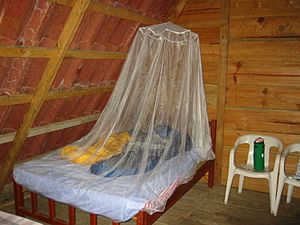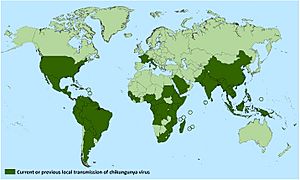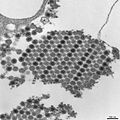Chikungunya facts for kids
Chikungunya is an infection caused by the Chikungunya virus (CHIKV). Symptoms include fever and joint pains. These typically occur two to twelve days after exposure. Other symptoms may include headache, muscle pain, joint swelling, and a rash. Symptoms usually improve within a week; however, occasionally the joint pain may last for months or years. The risk of death is around 1 in 1,000. The very young, old, and those with other health problems are at risk of more severe disease.
The virus is spread between people by two types of mosquitos: Aedes albopictus and Aedes aegypti. They mainly bite during the day. The virus may circulate within a number of animals including birds and rodents. Diagnosis is by either testing the blood for the virus's RNA or antibodies to the virus. The symptoms can be mistaken for those of dengue fever and Zika fever. It is believed most people become immune after a single infection. Recommendations include rest, fluids, and medications to help with fever and joint pain.
The best means of prevention is overall mosquito control and the avoidance of bites in areas where the disease is common. This may be partly achieved by decreasing mosquito access to water and with the use of insect repellent and mosquito nets. In November 2023 the FDA of the US has approved vaccine Ixchiq, the first of its kind, for individuals 18 years of age or older, for prevention of the disease.
While the disease typically occurs in Africa and Asia, outbreaks have been reported in Europe and the Americas since the 2000s. In 2014 more than a million suspected cases occurred. In 2014 it was occurring in Florida in the continental United States but as of 2016 there were no further locally acquired cases. The disease was first identified in 1952 in Tanzania. The term is from the Kimakonde language and means "to become contorted".
Contents
Signs and symptoms
It can take one to twelve days for a person to get sick after they get the chikungunya virus. (This period of time is called the virus's incubation period.) Usually, people get sick in three to seven days. Most people who get the virus (72% to 97%) get symptoms.
Chikungunya has an acute phase, which lasts a short time, and a chronic phase, which can last weeks, months, or years.
Acute phase
The acute phase usually begins with a sudden high fever that can last up to ten days. The fever is usually above 39 °C (102 °F), and can sometimes get as high as 40 °C (104 °F). About half of people with chikungunya get a rash, usually about two to five days after symptoms start. Some people also have gastrointestinal symptoms, like abdominal pain, nausea, vomiting, or diarrhea. In rare cases, people may get conjunctivitis or other problems with their eyes.
The body starts to fight the virus after about a week by sending out immunoglobulin M (IgM), which attacks the virus. After this, most of the symptoms usually start to get better. However, people often keep having some symptoms for about another week, like headache, insomnia (trouble sleeping), and exhaustion. After these symptoms end, the acute phase of chikungunya is usually over.
Chronic phase
In chikungunya's chronic phase, almost everyone with the virus (87% - 98%) gets very bad joint pain or stiffness. This usually lasts for weeks or months. However, it can last for years. The joint pain can be so bad that a person cannot move the joints that hurt. The pain almost always happens in more than one joint. Usually, people have pain in the joints in their arms and legs, on both sides. These may include the joints in the wrists, ankles, hands, feet, shoulders, elbows, and knees. The virus can also cause pain in the muscles or ligaments.
Sometimes, it can be difficult to tell the difference between chikungunya and dengue fever. Both infections cause some of the same symptoms, like fever and very bad pain. However, chikungunya usually does not cause bleeding. If a person diagnosed with chikungunya has bleeding problems, they may:
- Have dengue fever instead of chikungunya
- Have both chikungunya and dengue fever (both are spread by mosquitoes, and are common in some of the same places)
- Have both chikungunya and liver problems
Prevention
The best way for people to protect themselves from chikungunya is to protect themselves from mosquitoes in places where the disease is common. For example, people may use bug spray and mosquito nets, and wear long sleeves and long pants when they are outside. In places where chikungunya is common, governments can also do things to control the number of mosquitoes. For example, they can spray pesticides.
There is no vaccine for chikungunya. Scientists are doing experiments to try to make a vaccine. However, scientists say that even if they created a vaccine, people would still have to control mosquitoes to prevent chikungunya.
Treatment
There is no known treatment for chikungunya. No known anti-viral medicines (medicines which kill viruses) kill the chikungunya virus.
Medical professionals can only give "supportive care." This means they can only treat chikungunya's symptoms. For example, they may treat fever and joint pain with nonsteroidal anti-inflammatory drugs (NSAIDs) like naproxen; painkillers like paracetamol (acetaminophen); and fluids. Aspirin is not given because it can make bleeding more likely to happen.
Chronic joint pain
Scientists have not found any medication that helps everyone with chikungunya who has bad joint pain. There is some evidence that certain medicines may help people who have bad joint pain for more than two weeks. These medicines include:
- Ribavirin, an anti-viral medicine
- Chloroquine, a medicine usually given to prevent malaria
- Methotrexate, a medicine used for rheumatoid arthritis, which also causes very bad joint pain
These medicines do not help the symptoms of chikungunya during the acute phase.
Prognosis
About 1 in 1000 people who get chikungunya die from the disease. People older than 65, newborn babies, and people with other medical problems are most likely to have the most dangerous problems. Chikungunya is especially dangerous for newborns because they can get the virus from their mothers during childbirth, and because newborns' immune systems have to grow before they work as well as adults'. This makes it much more difficult for newborns to fight off the virus.
Elderly people, and people who already have arthritis, are more likely to have chronic joint pain.
Epidemiology

In the past, chikungunya existed mostly in developing countries. However, more recently, there have been epidemics (where a very large number of people get the virus) in the Indian Ocean, the Pacific Islands, and the Americas.
When chikungunya was first discovered in 1952, it was uncommon and happened only in West Africa. People usually got the disease during rainy seasons, because mosquitoes are more common during these times. Beginning in the 1960s, there were sometimes outbreaks in Asia and Africa. However, until 2005, chikungunya had been uncommon throughout the world.
Since 2005, chikungunya has become much more common. It has caused large outbreaks in Africa, Asia, and the Americas. For example, in India, chikungunya re-appeared after 32 years where no Indian person had gotten the virus. Outbreaks have also happened in Europe, the Caribbean, and South America, where chikungunya had never spread before. A few people have also gotten chikungunya in the United States and Australia, where the virus had never lived before.
In 2005, there was a very large outbreak on Réunion, an island in the Indian Ocean. Out of about 770,000 people who lived on the island, about 266,000 (over 1 in every 3 people) got chikungunya. In 2006, about 1.25 million people in India got the virus.
Chikungunya was recently spread to the Americas. From 2013-2014 in the Americas, 1,118,763 people have been thought to have the virus. Of these cases, 24,682 were proven to be chikungunya.
Some scientists think that chikungunya has become much more common because of a change in the virus's genetic code. This change may have made it easier for the virus to make copies of itself in mosquito cells. It may have also allowed the virus to be spread more easily by the Asian tiger mosquito (Aedes albopictus). This is important because the Asian tiger mosquito lives in many more places than Aedes aegypti, the other species of mosquito that spreads chikungunya to humans. Aedes aegypti lives only in tropical places. However, the Asian tiger mosquito spreads easily, and lives in Europe, the Americas, the Caribbean, Africa, and the Middle East.
History
Chikungunya was first described by Marion Robinson and W.H.R. Lumsden in 1955, after an outbreak in 1952 along the border between Mozambique and Tanganyika (now part of Tanzania). A group called the Makonde lived in this area. The word "chikungunya" probably comes from the Makonde language. It means "that which bends up" or "to walk bent over." This describes how people with very bad joint pain from the virus would bend into unusual positions.
The first recorded outbreak of chikungunya may have been in 1779. Scientific evidence agrees that the virus evolved around the year 1700.
Chikungunya was once researched as a possible biological weapon.
Images for kids
See also
 In Spanish: Chikunguña para niños
In Spanish: Chikunguña para niños





